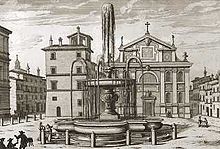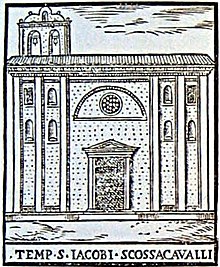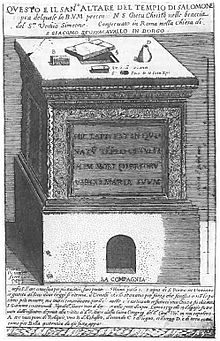
The Church of the Gesù is the mother church of the Society of Jesus (Jesuits), a Catholic religious order. Officially named Chiesa del Santissimo Nome di Gesù, its façade is "the first truly baroque façade", introducing the baroque style into architecture. The church served as a model for innumerable Jesuit churches all over the world, especially in Central Europe and in Portuguese colonies. Its paintings in the nave, crossing, and side chapels became models for art in Jesuit churches throughout Italy and Europe, as well as those of other orders. The Church of the Gesù is located at the Piazza del Gesù in Rome, and is one of the great 17th century preaching churches built by Counter-Reformation orders like the Jesuits in the Centro Storico.

Borgo is the 14th rione of Rome, Italy. It is identified by the initials R. XIV and is included within Municipio I.
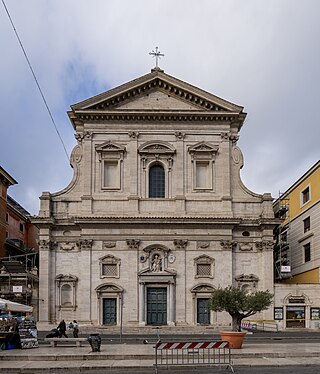
The Church of Santa Maria del Carmelo in Traspontina is a Roman Catholic titular church in Rome, run by the Carmelites. The bridge referred to is the Ponte Sant'Angelo. The church is on the Via della Conciliazione, the primary road of the Roman Rione of Borgo.

Santi Venanzio e Ansovino was a Roman Catholic church situated near the Capitoline Hill in Rome, in the area now occupied by the Piazza d'Aracoeli. It was dedicated to two saints associated with the city of Camerino: Venantius of Camerino, a martyr; and Ansovinus, bishop of Camerino. The church was also called SS Venanzio ed Ansovino de' Camerinesi.
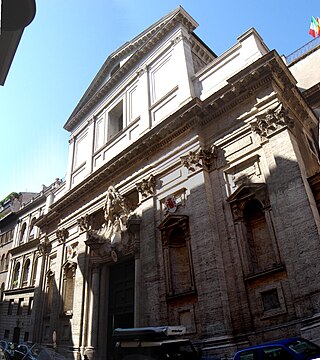
The Spanish National Church of Santiago and Montserrat, known as Church of Holy Mary in Monserrat of the Spaniards is a Roman Catholic titulus church and National Church in Rome of Spain, dedicated to the Virgin of Montserrat. It is located in the Rione Regola, at the intersection of alleyway of Via della Barchetta and the narrow Via di Monserrato, with the facade on the latter street, about three blocks northwest of the Palazzo Farnese.

La Chiesa di San Rocco is a Roman Catholic building that is part of the Parish of Saint Giacomo. The original conjoined building dates from 1499 and is located at 1 Largo San Rocco, Rome.

The Church of Saints Michael and Magnus is a Roman Catholic church in Rome, Italy, dedicated to Saint Michael the Archangel and the Bishop Saint Magnus of Anagni. It lies on the northern slope of the Palazzolo hill, in Rione Borgo, near the Vatican, and is the national church dedicated to the Netherlands. It is also known as the "Church of the Frisians". In 1989, the church was granted to the Dutch community in Rome. A 19th century source calls the church Santi Michele e Magno in Sassia, due to a location on a Vico dei Sassoni.

The Church of Saint Anne in the Vatican, known as Sant'Anna de' Palafrenieri, is a Catholic parish church dedicated to Saint Anne in Vatican City. The church is the parish church of the State of Vatican City and is placed under the jurisdiction of the Vicariate of the Vatican City and is located beside the Porta Sant'Anna, an international border crossing between Vatican City State and Italy.

Giovanni Battista Ricci nicknamed Il Novara after his birth town, was an Italian painter of the late-Mannerist and early-Baroque period, active mainly in Rome.
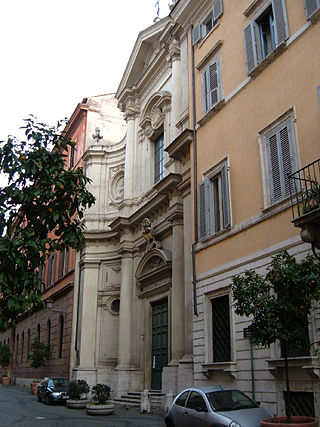
Santa Caterina da Siena is a church in Rome dedicated to Catherine of Siena. It is sited on via Giulia in the Regola district.

Palazzo Serristori is a Renaissance building in Rome, important for historical and architectural reasons. The palace is one of the few Renaissance buildings of the rione Borgo to have outlived the destruction of the central part of the neighborhood due to the building of Via della Conciliazione, the grand avenue leading to St. Peter's Basilica.

Palazzo dei Convertendi is a reconstructed Renaissance palace in Rome. It originally faced the Piazza Scossacavalli, but was demolished and rebuilt along the north side of Via della Conciliazione, the wide avenue constructed between 1936 and 1950, which links St Peter's Basilica and the Vatican City to the centre of Rome. The palace is famous as the last home of the painter Raphael, who died there in 1520.

Palazzo Alicorni is a reconstructed Renaissance building in Rome, important for historical and architectural reasons. The palace, originally lying only a few meters away from Bernini's Colonnades in St. Peter's square, was demolished in 1931 in the wake of the process of the border definition of the newly established Vatican City state, and rebuilt some hundred meters to the east. According to the stylistic analysis, his designer had been identified as Giovanni Mangone, a Lombard architect active in Rome during the 16th century.
Cristoforo Ambrogini was an Italian painter active in Rome in the late 16th - early 17th century. His only known works are the frescoes on the facade of the church of San Giacomo Scossacavalli in Rome, and those on the walls and the vault of the first chapel of the right nave in the same church. The chapel was restructured in 1600 by architect Antonio Longhi and was thereafter decorated by Ambrogini. San Giacomo was destroyed in 1937 for the erection of Via della Conciliazione.

Giovanni Mangone was an Italian artist active almost exclusively in Rome during the Renaissance. Mangone's skills were manifold: he worked as sculptor, architect, stonecutter and building estimator. Moreover, he was a keen antiquarian and among the founders of the Academy dei Virtuosi al Pantheon. As military engineer, he was renowned among his contemporaries.

Borgo Nuovo, originally known as via Alessandrina, also named via Recta or via Pontificum, was a road in the city of Rome, Italy, important for historical and architectural reasons. Built by Pope Alexander VI Borgia for the holy year of 1500, the road became one of the main centers of the high Renaissance in Rome. Borgo Nuovo was demolished together with the surrounding quarter in 1936–37 due to the construction of Via della Conciliazione.

Borgo Vecchio, also named in the Middle Ages Via Sancta, Carriera Sancta or Carriera Martyrum, was a road in the city of Rome, Italy, important for historical and architectural reasons. The road was destroyed together with the adjacent quartier in 1936–37 due to the construction of Via della Conciliazione.

Piazza Scossacavalli, also named Piazza di San Clemente, Piazza di Trento, Piazza d'Aragona, Piazza Salviati, was a square in Rome, Italy, important for historical and architectonic reasons. The square was demolished together with the surrounding quarter in 1937 due to the construction of Via della Conciliazione.

The Palazzo del Governatore di Borgo, also called Palazzo delle Prigioni di Borgo, Palazzo del Soldano, or Palazzo dal Pozzo, was a Renaissance palace in Rome, important for artistic and historical reasons. Designed by Antonio da Sangallo the Younger, it was demolished in 1936 for the opening of Via della Conciliazione.

San Michele Arcangelo ai Corridori di Borgo was a church in Rome dedicated to St. Michael, the Archangel, important for historical and artistic reasons.



